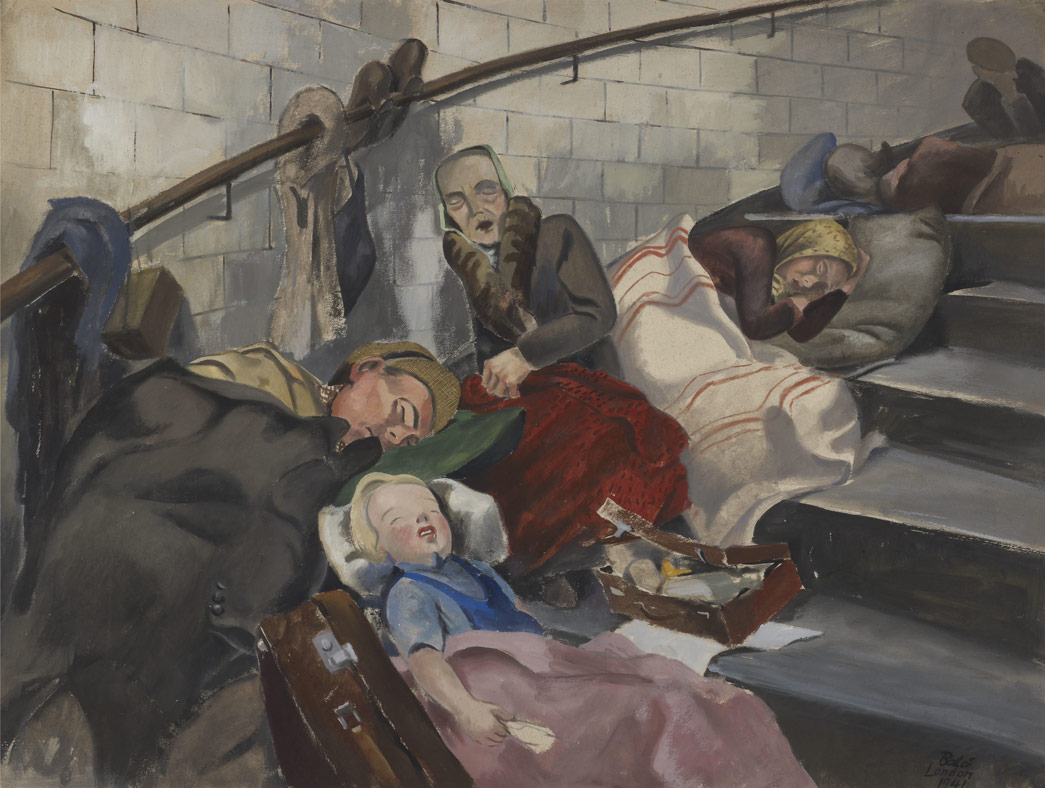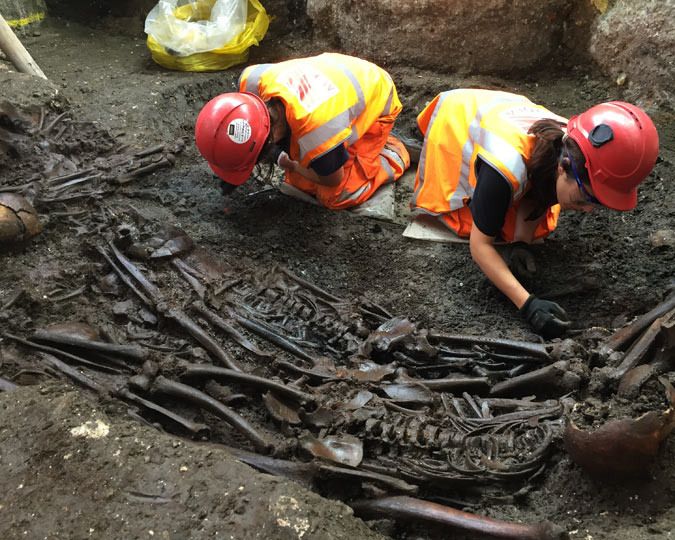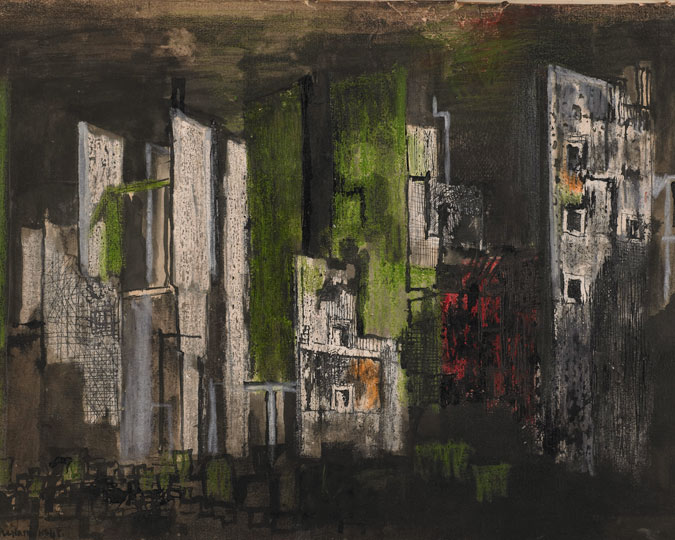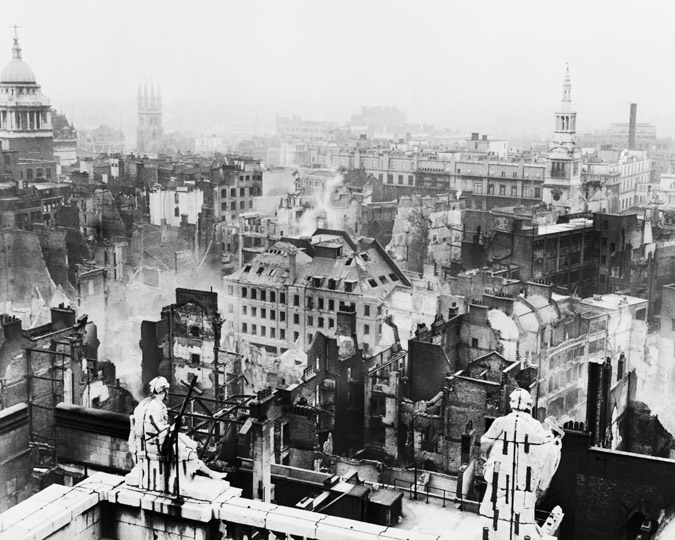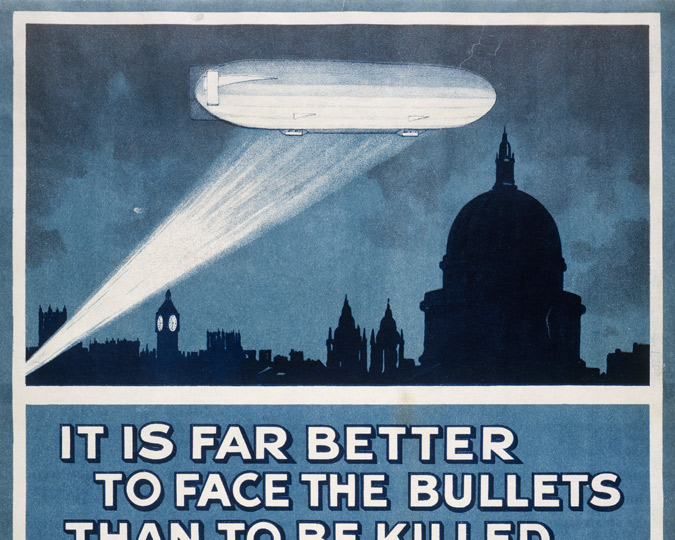Amongst the most powerful records of the home front during the Second World War are images of Londoners sheltering in the underground stations from air raids. Of these images, Bill Brandt’s photographs and Henry Moore’s drawings - both displayed in our spring 2017 exhibition Perspectives on Destruction - are perhaps the most famous. In the years since they were made, they have come to symbolise concepts such as the ‘Blitz Spirit,’ the idea of a stoic defiance in adversity.
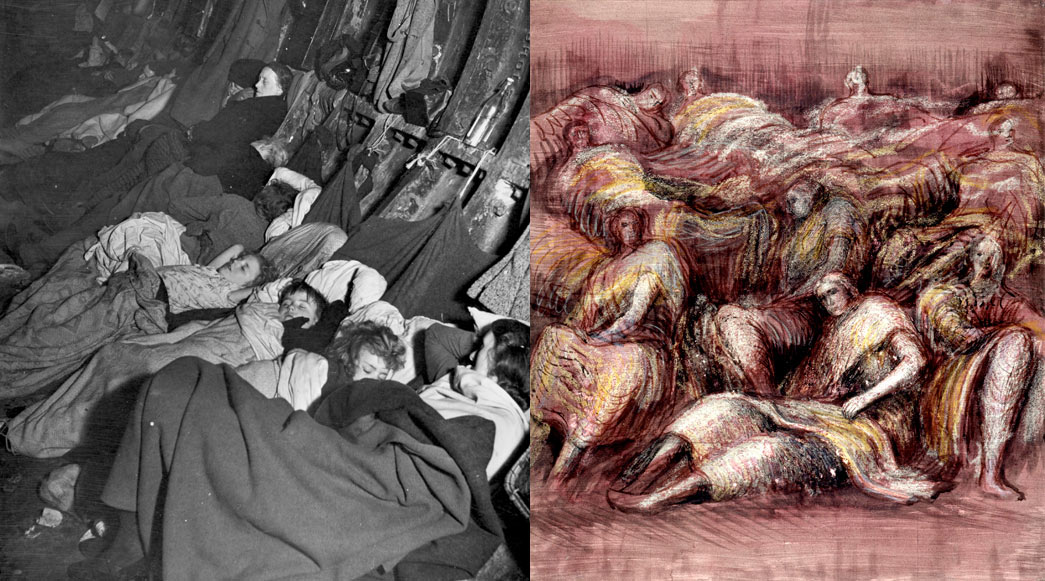
Londoners shelter during the Blitz
Liverpool Street Station underground shelter during the Blitz, Bill Brandt 1940, & Women in a shelter, Henry Moore 1941
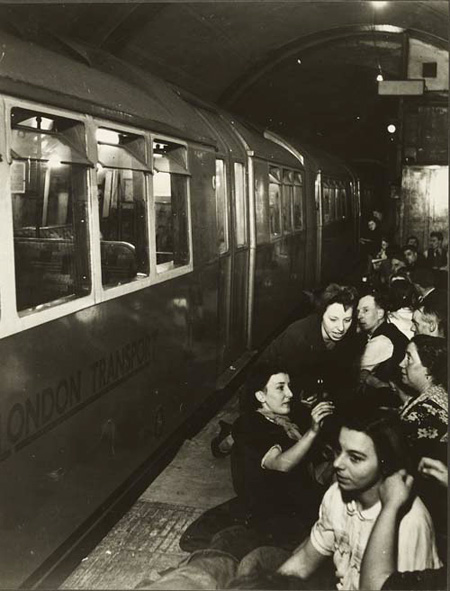
South East London underground shelter, 1940
Photographed by Bill Brandt.
Londoners began to use the underground for shelter after the first German air-raid on the city, on 7th September 1940. Initially, this was an unofficial occupation of the stations. Those taking shelter were, effectively, squatting. The government was uneasy about this, fearing amongst other risks that it could lead to the spread of disease, panic, the lowering of morale and even to people refusing to leave. But it quickly came to realise that, on the contrary, the underground as shelter was essential, as it allowed people a sense of control. Government research into the shelters at the time concluded that:
the way civilians stand up to continuous raiding depends largely on the feeling that there is a secure refuge somewhere.
The boosting of morale was central to the activities of the Ministry of Information (MoI) and of the associated War Artists Advisory Committee (WAAC). In 1940, the threat of a German invasion was real and it was politically crucial to present as positive a message as possible, both at home and abroad. This was particularly so in the case of the USA, which would not enter the war until December 1941.
It was against this background that the Ministry of Information commissioned Brandt to document life in the shelters. His images were endlessly reproduced and exhibited, and a set of prints was even sent to President Roosevelt to persuade him to maintain US support for Britain. In the end, Brandt managed to devote little more than a week to the project before influenza forced him to stop work, having made around thirty-nine images. At least one other MoI photographer continued, however, resulting in a bank of over 200 images which record life in the shelters.
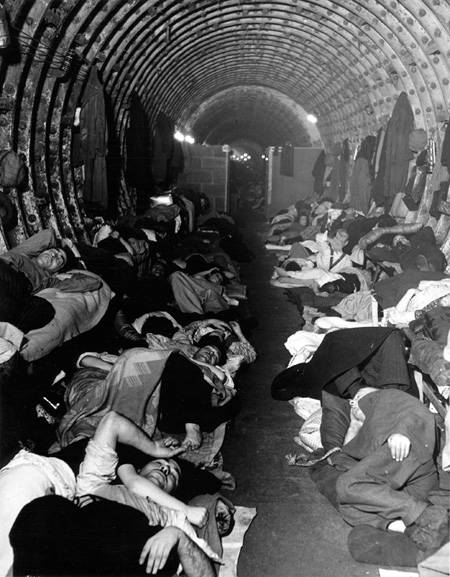
Londoners shelter in Liverpool Street station during the Blitz, 1940
Bill Brandt
Although the brief was to document life in the tube station shelters, Brandt’s photographs evolved into an examination of the larger implications of this situation. Like Henry Moore, he saw the tube shelters ‘as places that gave the appearance of death, even as they preserved life’. Brandt’s photographs of large numbers of sleepers side by side on a platform play on this ambiguity. As his biographer, Paul Delany says, seeing so many bodies in this way calls to mind precisely the laying out of corpses following an air raid. This reflects the complex circumstances of these spaces. In many ways, people did generate a resilient community spirit, as the popular press at the time liked to present it. On the other hand, there was little privacy, facilities were scarce and threats, both from within the shelters and from the skies above, were real. As Moore observed:
People who were obviously strangers formed tight little groups. They were cut off from what was happening above, but they were aware of it. There was tension in the air.
Moore’s own initial experience of the shelters came about when he saw people sleeping on the platform at Belsize Park station. He wrote later that his first impression was the similarities with his own sculpture, and this prompted him to make the drawings. ‘I had never seen so many reclining figures and even the holes out of which the trains were coming seemed like the holes in my sculpture’. In January 1941 he was made an official War Artist, which gave him far greater freedom of access to the shelters. Although he visited underground shelters across London, many of the drawings derive from scenes on the Central Line between Liverpool Street and Bethnal Green.
Unlike Brandt, Moore did not actually make work, except perhaps brief notes, in the shelters. His first drawings were, in fact, based on photographs published in the illustrated magazine, Picture Post. One reason for this, he wrote, was that ‘it would have been like making sketches in the hold of a slave ship’. Apart from his own sense of what was acceptable, there was also the question of what the people themselves thought. Strangers with cameras, taking notes and making sketches were, perhaps, tolerated if they were officials, but they could easily be mistaken for spies. The painter Graham Sutherland, for instance, complained that his official documents did not prevent him being arrested on a number of occasions.
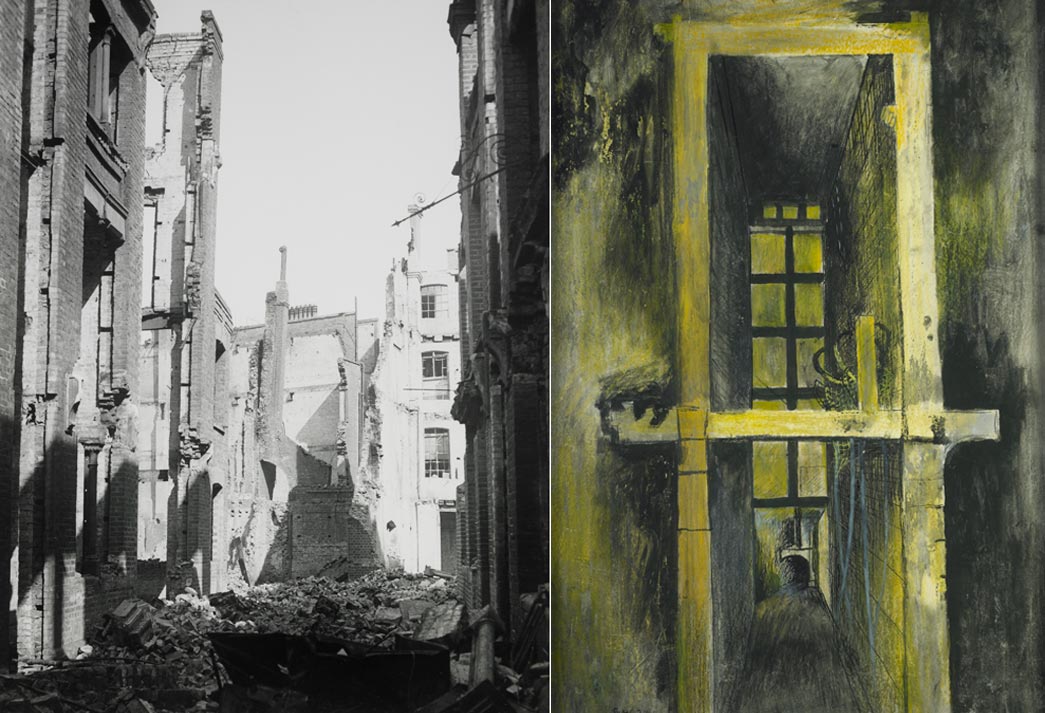
Two war artists' views of the Blitz, 1941
City bomb damage: Bishopsgate Avenue by Arthur Cross, 1941; Devastation City; Burnt out Interior; Silence by Graham Sutherland, 1941
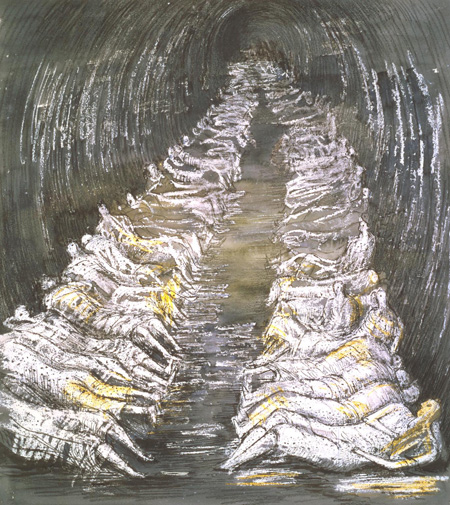
Tube Shelter Perspective, 1941
Henry Moore. Tate Britain, CC-BY-NC-ND.
As with Brandt’s photographs, Moore’s drawings convey complex attitudes towards the underground shelters and the circumstances of the people who sought refuge in them. He employs a wax resist technique which creates a scabby surface like water-damaged plaster; his figures are simplified in ways which call to mind the body-casts excavated at Pompeii. There is an awkwardness, in other words, which creates an atmosphere of unease. One could say that Moore’s drawings are as much about human vulnerability as they are about resilience.
Although the visual record appears to be overwhelmingly of tube stations, the amount of people taking shelter in them was proportionally small. In central London, the underground was close at hand and allowed large numbers to quickly escape danger. The greatest number of people in the underground on any one night has been estimated as 177,000 on 27th September 1940, a sizable figure, but this only represents approximately 5% of London’s wartime population.
The districts most at risk from the bombs were those in the east and south of London, areas associated with industry, which had large working class populations. During the Second World War, these areas were relatively poorly served by the Underground system. One exception was the Central Line, which was being extended when war broke out. Construction work ceased as the war escalated. Instead, at the height of the Blitz, the empty tunnels and stations, such as Bethnal Green, were used extensively as air-raid shelters. In areas where there was no tube, however, large public shelters were located in shop basements, church crypts and beneath railway arches. Those fortunate enough to have a garden could install an Anderson shelter, a form of small shed buried in the ground. A census of public shelters conducted in November 1940 suggested that Londoners used the options available in roughly the following ways:
- 4% in the Underground or equivalent big shelters
- 9% in public (mostly street-type) shelters
- 27% in their own shelters (mainly Anderson-type garden shelters)
In other words, around 60% of the population of London simply stayed at home.
Visit our permanent gallery
Learn more about the impact of the bombing raids on east London in our Docklands at War gallery at the Museum of London Docklands.
Join the newsletter
Love art and photography? Subscribe to our free photography newsletter to read more stories from our collections, and see upcoming events and exhibitions.








